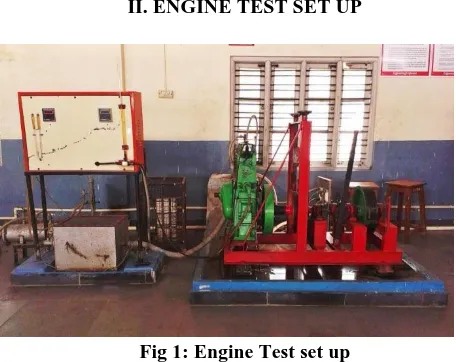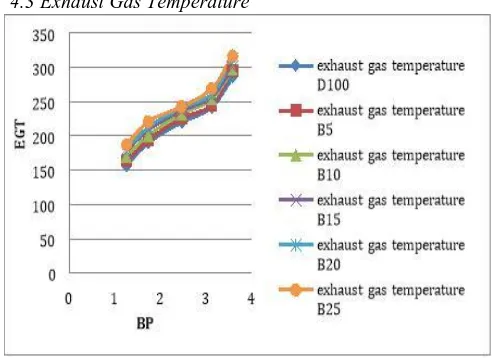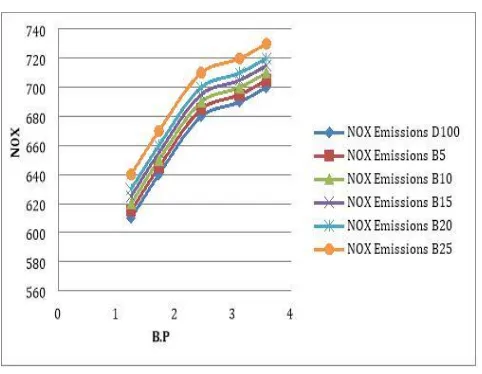Abstract-:Energy has become a crucial factor for humanity to continue the economic growth and maintain high standard of living especially after industrial revolution. “Fossil fuels are still the main source of energy. But the endless consumption of fossil fuels will bring the reserve to an end in near future. As a result fuel prices are soaring because of diminishing supply than demand. So researchers world over are in constant search of alternate fuels in the last three to four years, aimed at reducing CO2 emissions and global dependency on fossil fuels. The use of vegetable oils as a fuel in diesel engine causes some problems due to their high viscosity compared with conventional diesel fuel. Various techniques and methods are used to solve the problems resulting from high viscosity. One of these techniques is blending of fuel.
In this study, a mix of 5%, 10%,15%, 20%, 25% sesame oil and diesel fuel was used as alternative fuel in a direct injection diesel engine. Diesel engine performance and exhaust emissions were investigated and compared with the diesel fuel in a diesel engine. The experimental results show that the engine power and torque of the mixture of sesame oil diesel fuel are close to the values obtained from diesel fuel and the amount of exhaust emissions are lower than those of diesel fuel. Hence it is seen that mix of sesame oil 20% and 80% diesel fuel can be used as an alternative fuel successfully in a diesel engine without any modification and also it is an environmental friendly” fuel in terms of emission parameters.
Keywords: Sesame oil, Diesel, Bio-Diesel, Alternate fuels, Performance, Emissions
I. INTRODUCTION
Biodiesel is an “alternative or additive to standard diesel fuel that is made from biological ingredients instead of petroleum (or crude oil). Biodiesel is usually made from plant oils or animal fat through a series of chemical reactions. It is both non-toxic and renewable. Because biodiesel essentially comes from plants and animals, the sources can be replenished through farming and recycling. Biodiesel can be made from numerous natural resources. Although animal fat can be used, plant oil is the largest source of biodiesel. Soya bean oil, rapeseed oil, canola oil, palm oil, cottonseed oil, sunflower oil etc, are already used to produce biodiesel.
The interest in bio-fuels has increased significantly amid unstable oil prices. At the same time, the cost of hydrogen
Revised Version Manuscript Received on 05 August, 2019.
Srikanth Vadlamudi , Department of Mechanical Engg., Anurag Group of institutions, Hyderabad,Telangana, India. (email:srikanthmech@cvsr.ac.in)
R .Naresh Kumar goud , Department of Mechanical Engg., Anurag Group of institutions, Hyderabad,Telangana, India. (email:naresghgoudmech@cvsr.ac.in)
Dr.T.Krishnaiah , Department of Mechanical Engg., Anurag Group of institutions, Hyderabad,Telangana, India. (email: krishnaiah.talari@gmail.com)
technology and the impracticality of delivering hydrogen remain high. Recent research has cast into doubt the cleanliness of electric vehicles. The net CO2 saving of these
vehicles depends heavily on how the electricity is produced. A large percentage of power stations are driven by fossil fuels. These factors have encouraged several auto manufacturers to focus on a fuel source that can deliver performance with sustainability like bio-fuels.
An improved knowledge of the potential to reduce regulated emissions from the use of biodiesel and its blends with petro-diesel could help
Engine manufacturers to adapt their engines to the use of biodiesel and to optimize them, readjusting the compromise between efficiency, costs (mainly due to after treatment systems) and emissions within the regulation limits,
National administrations to design their energy policies and to define measures to externalize environmental costs,
Local administrations to promote its use in urban areas, especially in countries with extreme dieselization, where particle concentrations in the air are reaching alarming levels, and
Private users, to encourage them to use biodiesel, attesting to their environmental concern.
Sesame (Sesamumindicum L.) is an important oilseed crop that ranks sixth in the world among vegetable oils. Out of the 3.66 million tons of sesame produced in the “world, Asia and Africa account for 2.55 and 0.95 million tons, respectively. Nigeria is the third largest producer of sesame in Africa after
Sudan and Uganda. Unfortunately, the net export of Africa sesame is just 38% of its production despite the favorable weather conditions to grow this crop on a large scale for commercial purpose. At present, majority of the primary growers of sesame in Africa produce non- certified organic sesame which can readily meet the specific requirements for organic sesame. Recently released sesame varieties: NCRIBEN-01M and NCRIBEN-02M, and Ex-Sudan (exotic variety) readily meet the premium quality requirements for sesame export (1000 seed weight >3.0 g, 40-50% oil content and pearly-white seed colour). Seeds of two local cultivars
PERFORMANCE OF DIESEL ENGINE
USING BIO-FUEL FROM SESAME OIL
(dark and white) of Sesame (Sesamumindicum L.) were chemically analyzed for their Physico-chemical characters specific gravity, refractive index, acidity, peroxide value, iodine number, Saponification number and unsaponification unsaponified matter. Six mineral nutrients calcium, phosphorus, potassium, magnesium, sodium and iron contents of the seeds were also determined. The mineral composition Sesamumindicum seeds revealed relatively high amounts (mg/100g) of Ca (1200),P (580), K (374), Mg (185), Na (72), Fe (10.6) and low amount of Zn (3.8) The results were compared with some other cultivars growing worldwide. Our results revealed that incorporation of sesame seeds in bakery industry at suitable levels may satisfy the recommended daily dietary allowances of minerals (N.R.C.), as shown by chemical analysis of sesame seeds, confirming it as the richest source of most of the inorganic” nutrients.
[image:2.595.309.537.53.234.2]II. ENGINE TEST SET UP
[image:2.595.328.554.269.449.2]Fig 1: Engine Test set up
Table 2: Specifications of the engine
III. TEST PROCEDURE:
The engine performance test was conducted on a single cylinder, four-stroke single cylinder engine. The engine was directly coupled to an “Eddy current dynamometer that permitted engine motoring either fully or partially. The schematic diagram of the experimental setup is depicted in Figure and the engine characteristics are cited in specifications of engine. The fuel is supplied to the test engine by a tank, which could easily be drained with the help of three way stop valve for Change of fuel. A glass burette of 100cc was also attached in parallel to this tank and was used for fuel flow rate measurement. For every fuel change the fuel line was purged out of the residual fuel. The engine was made to run under full load for at least 30 minutes to stabilize on new fuel conditions. Test-rig was provided with necessary equipment and instruments for recording the dynamic combustion pressure and crank-angle measurements.
1.The engine was started in neat petrol mode at no load condition.
2.The engine speed, time for 10 cc petrol consumption, exhaust temperature and Exhaust Gas analyzer values were noted
PARTICULARS SPECIFICATIONS
Make Kirloskar oil engines, India
Engine Four stroke single cylinder
BHP 5 HP
Speed 1500 rpm
Fuel Diesel
No. of cylinders Single Bore diameter 80 mm Stroke length 110 mm
Starting Hand start with cranking handle Working cycle Four stroke
3.The above steps were repeated from no load to full load up to 13kgs.
4.The bio-diesel and diesel fuel substitutions are enter into the fuel tank substitution percentages are 5%,10%, 15%,20%, 25%.
5.First enter the bio-diesel of 5% blended with diesel. 6.The engine speed, time for 10cc petrol consumption, exhausts temperature and Exhaust Gas Analyzer values were noted.
7.The process was repeated at no load and at load conditions.
8.The similar procedure was followed for 5%, 10%, 15%, 20%, 25% and 100% bio-diesel and diesel blends.
9.All the observations for the various loads of substitutions and were tabulated and the efficiency obtained in each case was calculated.
10. The values of efficiency exhaust temperature, total fuel consumption and, emissions” were compared for bio- diesel and diesel fuels5%, 10%, 15%, 20%, 25% blends of” diesel conditions.
IV. RESULTS & DISCUSSION
[image:3.595.315.545.57.222.2]4.1 Brake Thermal Efficiency
Fig 2: Brake Power vs Brake Thermal Efficiency
It is observed that “brake thermal efficiency indicates the ability of the combustion system to accept the experimental fuel, and provides comparable means of assessing how efficient the energy in the fuel was converted to mechanical output. The relationship between brake thermal efficiency and brake power with diesel and other blends of bio diesel is shown in the above figure. The thermal efficiency increase up to a certain load and then decreases, the highest thermal efficiency was observed at 3/4th load.
[image:3.595.63.284.320.484.2]4.2 Brake Specific Fuel Consumption
Fig 3: Brake Power vs Brake Specific Fuel Consumption
It is observed from the above figure that the BSFC for all the fuels decreases with increase in load. “This is due to higher percentage increase in break power with load as compared to increase in the fuel consumption and due to the presence of oxygen in the biodiesel and its blends that enable complete combustion and the negative effect of increased viscosity would not have” been initiated.
4.3 Exhaust Gas Temperature
Fig 4: Brake Power vs Exhaust Gas Temperature
[image:3.595.310.557.330.509.2]4.4 Carbon Monoxide
[image:4.595.317.549.52.209.2]
Fig 5: Brake Power vs Carbon Monoxide The comparison “of carbon monoxide for various biodiesel blends with respect to brake power shows in above figure. Carbon monoxide (CO) occurs only in engine exhaust, it is a product of incomplete combustion due to insufficient amount of air or insufficient time in the cycle complete combustion. It is observed that the CO emissions for B25 and its blends are lower than for diesel fuel. This is due to their more complete oxidation as compared to diesel. Some of the CO produced during combustion of biodiesel might have converted into CO2 by taking up the extra oxygen molecules present in these
chain and thus reduces CO formation. We can clearly note that the B25 blend” has less CO emission..
[image:4.595.43.289.53.233.2]4.6 Nitrogen Oxides Emissions
Fig 7: Brake Power vs Nitrogen Oxide Emissions
[image:4.595.46.287.413.600.2]Variations “of NOx with engine Brake power for different fuels tested are presented in above figure. The nitrogen oxides emissions formed in an engine are highly dependent on combustion temperature, along with the concentration of oxygen present in combustion products. For blend B25 we have observed the highest NOX emission while lowest is observed for diesel. This is due to higher combustion temperature inside the cylinder at higher load. In general, the
Fig 8: Brake Power vs Smoke Density
The Smoke emissions for B25 blend have increased as there might be oxygen level high during its combustion. Smoke “is formed due to incomplete combustion of fuel in the engine cylinder. Then blend B25 has shown high soot in the smoke. However the smoke density has consistent increase in blends of B5, B10, B15, B20. While diesel has the lowest smoke density values. The smoke density increases as the percentage of biodiesel increased. This is due to the higher viscosity and poor volatility of higher blends of bio-diesel as compared to lower blends which was more dominating over inherent oxygen and higher Cetane number and was mainly due to emission of heavier molecules” of hydrocarbon and particulates.
V. CONCLUSION
The “results of present work are summarized as follows: As no engine modifications are required sesame biodiesel may be directly used in any diesel engine.
Only short term tests were conducted, long term tests may reveal clearer picture of engine operation and life.
The engine develops maximum rate of pressure rise and maximum heat release rate for diesel compared to sesame and its blends. With increase in percentage of sesame in the blend, the maximum rate of pressure rise and maximum heat release rate decrease
The specific fuel consumption increases with increase in percentage of sesame in the blend due to the lower calorific value of sesame.
The brake thermal efficiency decreases with increase in percentage of sesame in the fuel.
REFERENCES
1. Improved “conversion of plant oils and animal fats into biodiesel and co-product-Praveen r. Muniyappa, Biosource technology, volume 6,issue 1,april 1996, pages19-24.
2. Biodiesel production: a review-FangruiMa,biosource technology , volume 70,issue 1,october 1999, pages 1-15 3. Triglycerides based Diesel Fuels-Anjana Srivastav, Ram
Prasad- Renewable and Sustainable Energy Reviews 4(2000) 111-133.
4. Biodiesel fuels from vegetable oils via catalytic and non-catalytic supercritical alcohol transesterification and other methods:a survey-AyhanDemirbas, Energy conversion and management, volume 44, issue 13, august 2003, pages 2093-2109.
5. Experimental Investigation on diesel engine fuelled with diesel and biodiesel extracted from sesame oil, Addanki Sreenivasulu ,Dr.L. Rasidha, IPASJ International Journal of Mechanical Engineering (IIJME), Volume 4, Issue 9, September 2016.


